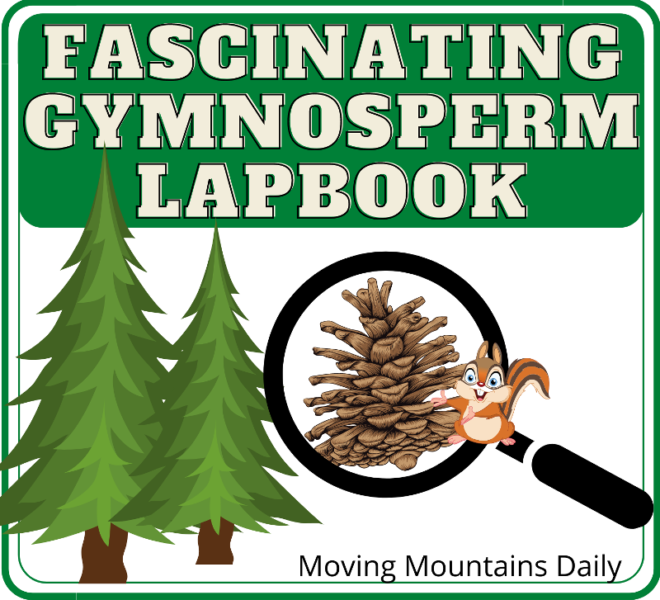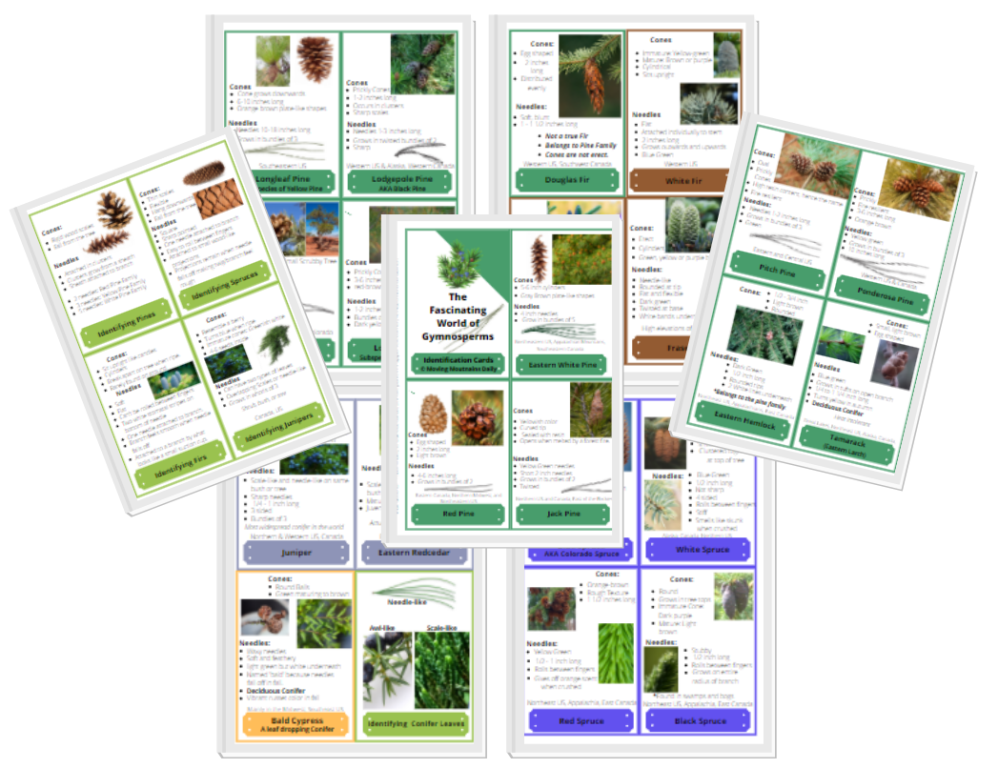Let’s explore the fascinating world of gymnosperms with some fun science experiments. Want to see a gymnosperm? Find a cone!
There are two types of seed plants: angiosperms and gymnosperms. The basic difference is whether the seeds are produced inside the plant or on the outside. Gymnosperm comes from a Greek term that means “naked seed”. Cones, for example, are gymnosperms. It depends on where you live, but you might have one in your backyard!

Conifers
Conifers are a group of cone-bearing gymnosperms that are found in the northern latitudes . These trees keep their green needles all year around and are considered part of the evergreen family – that’s because they are for-evergreen! (Get it?!)
Let’s separate facts:
- All evergreens stay green, even in the winter.
- Conifers are one subgroup of evergreens that bear cones.
- Not all evergreens produce cones.
- Only pine trees can produce pinecones.
- It is perfectly acceptable to write pinecone as a compound word or as two individual words. (Eeee-yeah, had to look that up!)
The pinecone isn’t a flower or a fruit, instead it is a hard, woody-seed-protector. Maine’s state flower is the pinecone. It is the only state to have a state flower that isn’t!
Male or Female Cone
If you have ever gathered cones, you have collected the female cones. The soft male cones are typically found on the same tree, but are rarely noticed. Pinecones can stay attached to the tree for up to 10 years! It is important to leave the cones on the trees and only collect from the ground.
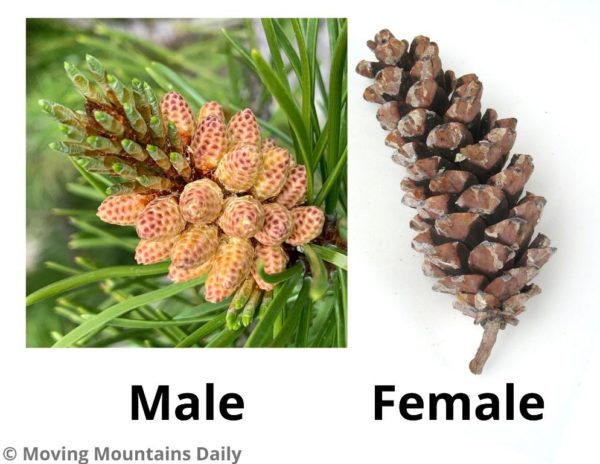
Cone Duty and Pollination
The male cone’s job is to release pollen and pollinate the female cone. We always think of pollination as an insect’s job, however, all conifers are wind pollinated. The male cones release pollen that is picked up by the wind. Its job is to find a female cone and fertilize the eggs. A single grain of pollen holds all the genetic information it needs.
When pollen lands on a female cone, it grows a long, thin pollination tube that inserts itself where the egg is located. When the genetics from both, the egg and pollen are combined, a fertilized embryo begins to grow. After two years, the embryo grows into a seed and the cone becomes brown and develops scales. The seeds are found laying on top of the woody scales.

The female cone’s job is to protect the naked seed. When needed, the pinecone will close up if it needs to protect the seeds from moisture and extreme temperatures. When the weather is dry and warm, the cone will open up and allow the seeds to fall out. The seeds will be dispersed either by wind, water runoff, or animals moving the pinecones around.
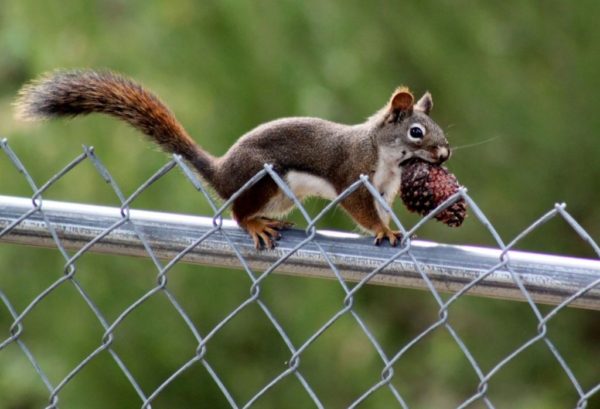
Printable Directions and Worksheets
Can we prove what will happen if a pinecone falls into a mud puddle? What will happen after the water dries up? Can a pinecone really determine the level of humidity in the atmosphere? How does a pinecone protect future generations? Andrew and I have chosen two science experiments that will answer all these questions, and more!
We also thought it would be helpful to provide free printable experiment instructions and worksheets. In Experiment #1, you can prove what happens when a pinecone gets wet. Experiment #2 turns a pinecone into a humidity-reading hygrometer.
If you are already following us (unless you use a different email address), the process is more like signing-in! The pintables will be delivered to you via email.
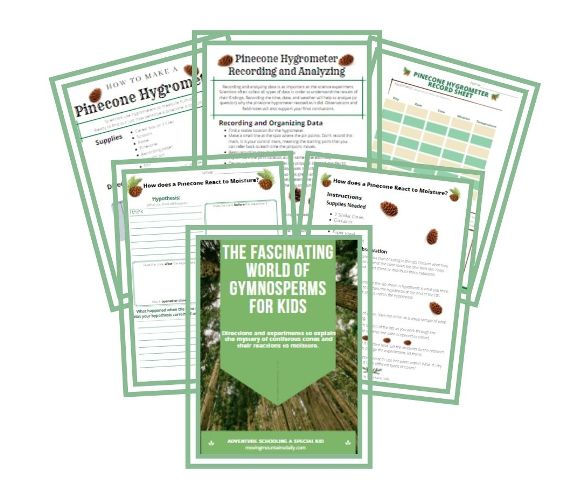
Science is not always predictable!
Both experiments were fascinating. The first experiment proved what would happen when a pinecone falls into a mudpuddle. Always try to ask what-if questions. Andrew’s what-if involved using a blow dryer to imitate the wind. It did, but proved to take a bit longer than he had patience for!
We took the second experiment and created a lab sheet so that we could analyze the data from the pinecone reactions to humidity in the air. We were in for some surprises!
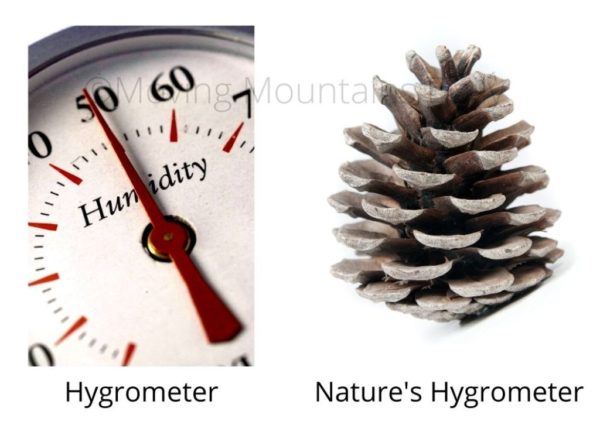
A hygrometer is a device that measures the amount of moisture in the air.
Andrew’s hygrometer hypothesis stated that pinecones would close and open appropriate to the amount of humidity in the air. He also determined that sunny days were dryer than rainy days so the pinecone would open on sunny days and close tighter during the rain. Sounded logical – but was it?
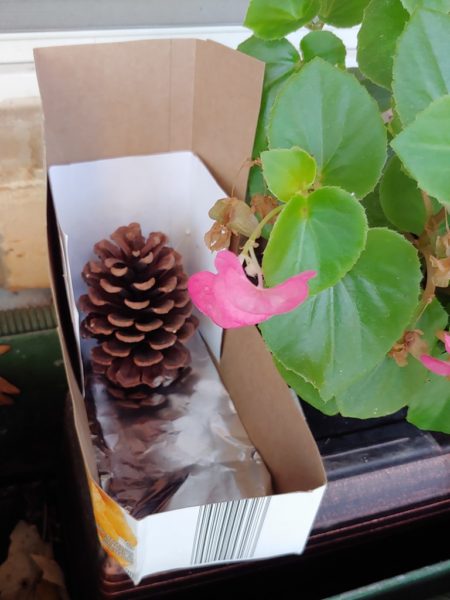
Hygrometer Success!
Since it has been a damp fall, I was skeptical at just how much change would happen. When a pinecone closes, it indicates high humidity. A pinecone with open scales indicate the weather is dry and humidity is low. To me, the days were just plain gray and damp. I didn’t feel any difference – but the pinecone did!
Turns out, our pinecone was a natural hygrometer. It determined the differences in humidity throughout the day. Even though, I, personally felt like the weather was just plain ‘damp and cold‘, there were definitely differences in the levels of humidity!
Our Hygrometer Record:
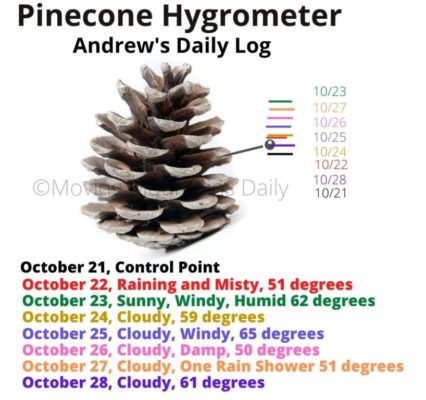
Experiment Analysis
Andrew’s hypothesis seemed rather accurate – except that our ‘one’ sunny day was more humid than the days that it rained. It was so humid, the car windows in the garage were wet and the cement floor, damp. Andrew had to really dig to figure out why.
Our Determination
October 22nd was a gross rainy, wet, misty, foggy 51 degree day. That night the weather cleared but became warmer, instead of colder, which would have been typical for clear summer skies. The clouds hold in the warmth but as soon as the skies clears, the temperature (normally in the colder months) gets colder. Not so, on this day. The temperature went up to a balmy, 62 degrees. Off came the long-johns, out came the shorts, and the leaf blowers. We were sweatin’ our tails off while doing yard work! Our pinecone wasn’t too happy because it closed, give or take slim little openings between the scales! This created a huge gap in lines between October 22nd and 23rd. The rest of the humidity levels were up and down and varied by day. We also noticed that it didn’t always take rain to have high humidity.
Try the experiment, we think you will enjoy it!
Other Factors
Humidity is not the only change that affects gymnosperms. Some types of conifers, like the Balsam Fir tree, produce cones that shatter when the seeds are ripe. These fragile cones are rarely found laying on the ground.
Other types of gymnosperms, like the Lodgepole Pine or the Jack Pine have cones that opens only after a forest fire. Forest fires are devastating in many ways, but they are also very beneficial to a forest. The Lodgepole and Jack Pine certainly benefits, but so does the soil because it gains nutrients from the remaining ash.
Pinecone Time Lapse
Check out this cool time lapse of an opening pinecone from Bach Educational Resources:
What to do when the gymnosperm seeds that fall from the cone:
Plant or spread the seeds!
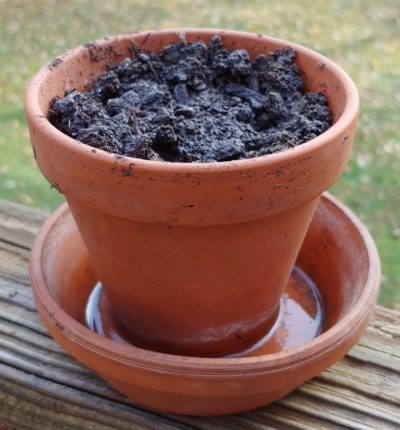
Will they grow? I know other families who have grown conifers from seeds. We are still waiting on this experiment!
Drop a comment below and tell us about your experiences with gymnosperms!
Update** Andrew had so much fun learning about pinecones that we continued our conifer study. Check out, “Taking the Confusion out of Conifers for Kids.” This particular unit should be completed over a 5 day period, or more if you need to cut it into bite size pieces.
Check out our Gymnosperm Digital Downloads!
The Fascinating Gymnosperm Interactive Lapbook
The Fascinating Gymnosperm Lapbook, © Moving Mountains Daily, is completely planned out – all you must do is cut and paste each element where it belongs. When finished, the lapbook becomes an interactive support tool – perfect for teaching, studying, or reviewing all the information learned in the gymnosperm study unit! Kids love mini books, flaps that flip, and pockets for pictures and cards, while teachers and homeschool moms like how a file folder can hold so much information! Check out The Fascinating Gymnosperm Lapbook!
The Gymnosperm Identification Field Guide Packet
Ready to do some field work and identify conifers? The identification cards included in the lab worksheets at Taking the Confusion out of Identifying Conifers for Kids were so popular that we received requests for a more extensive collection. Here is our new color-coded field guides!
The Gymnosperm Identification Field Guide Packet set includes 5 Identification Category Cards, as well as 22 types of species. Identification field guide cards requires kids to use critical thinking and scientific deduction. Like all thing’s science, there is a process which begins with determining the species and then gradually narrowing it down. Check out these new color coded field cards in our new digital download section!
